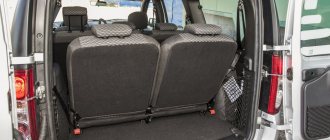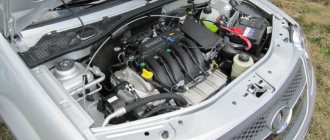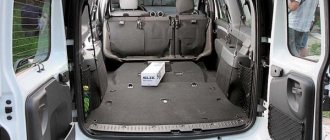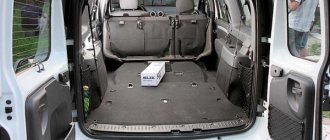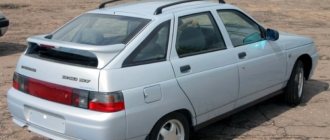LADA Largus has long won the sympathy of Russian car enthusiasts. Drivers often pay attention to the large trunk volume of the Lada Largus, which is considered the main advantage of this car. Domestic cars also cope well with another task - providing inexpensive and comfortable travel on modern roads. These two aspects and the ability to accommodate a large number of passengers allowed the car, produced at the Russian AvtoVAZ, to become a popular model in the CIS countries.
Trunk size Lada Largus station wagon 5 and 7 seats, van, Cross
Whatever the size of the Lada Largus trunk, it will never be enough. Of course, if you are buying a car solely for transporting yourself and infrequent trips to the country, then you are unlikely to say that the luggage compartment in Largus is small. However, those who take this station wagon for work will never say that the trunk of the Lada Largus is large and there is a lot of space in it. After all, there is never too much working volume.
As you already know, LADA Largus is available in three modifications:
— Passenger station wagon R90. — A station wagon with increased capacity (the so-called 7-seater station wagon). — F90 cargo van.
All these modifications are tailored to suit your needs and have different luggage compartment volumes. Let's start with the R90 passenger station wagon.
Are there any competitors?
Due to its body layout, the Lada Largus does not have a large number of its “opponents,” especially in the market spaces of the CIS countries. This can be partly explained by moderate demand. If we again tend to limit ourselves only to post-Soviet market areas, then we are unlikely to find a worthy competitor to this station wagon in terms of carrying capacity. Impressive figures can serve as a simple confirmation of this:
- the van is able to overcome a weight of 800 kg;
- the station wagon can handle a 650-kilogram load, the volume in liters allows this.
Competitors are only able to get closer to these indicators, because their load capacity is at the level of 450-600 kg. The list of dimensional characteristics of the Largus trunk may bring a little disappointment, because in this discipline the station wagon is not a leader, but it is not “tagging along” in the “tail of the tournament bracket”.
Detailed information regarding dimensions is most clearly reflected in the following table:
As you can see, two positive aspects speak in favor of the universal “Russian woman”:
- enviable convenience when loading luggage, especially large ones, which is facilitated by the door opening limit (reaches 180 degrees with the doors fully turned out); Not a single universal model can boast of this feature;
- reasonable cost of the car, which is especially noticeable in comparison with famous competitors.
Important! Against the background of the entire set of indicators characterizing the versatility of the LADA Largus, it can be unequivocally stated that the domestic model, although in some minor disciplines loses to its rivals, in general terms, against their background it looks very decent and advantageous. Here, few will argue with the functionality of the “Russian woman”.
Trunk capacity Lada Largus 7 seats
The trunk volume of the Lada Largus 7 seats is very, very modest - only 135 liters. This is due to the fact that the car has been adapted for greater passenger capacity. However, if you fold the third row of seats, you can easily increase the luggage compartment volume of a seven-seater station wagon to approximately 500-560 liters. The figure is not entirely accurate, since we take into account the trunk volume of the five-seater version of the station wagon, which is 560 liters. But useful space will still be occupied by folded seats. 560 liters will be if the third row of seats is removed and removed from the car.
If you fold down the second row of seats, then the trunk volume of the Lada Largus for 7 seats will be a decent 2350 liters.
Peugeot Partner
Peugeot Partner is another representative of the minivan segment. The standard version of the car body is capable of carrying 625 kilograms, and the extended version by 25 cm is capable of carrying 750 kg. The standard version is equipped with a 90 hp gasoline engine, and the extended version is equipped with a 90 hp diesel engine. Both engines are complemented by a five-speed manual gearbox. The price of the standard version starts at 599 thousand rubles, although this configuration does not have side cargo doors. The extended version already has side doors in the initial basic version, and its cost starts at 666 thousand.
Peugeot Partner is a full-fledged competitor in terms of cargo volume
The passenger version has a 5-seater cabin and has many convenient drawers for things. In this version, the car is equipped with a 90-horsepower gasoline engine, front airbags, and electric windows. The passenger version of the Peugeot Partner can be equipped with a 120-horsepower engine; this option will cost from 687,000 thousand rubles.
Luggage compartment volume Lada Largus Van
The Lada Largus Van has the most impressive figures - its trunk volume is 2540 liters. This car is in great demand among commercial organizations, so special attention was paid to the trunk volume when designing this car.
There is another version of the Lada Largus station wagon - a CNG gas fuel version with a trunk volume of 2225 liters. This is slightly smaller than a regular van due to the gas cylinder placed inside.
Volkswagen Caddy
Another competitor is the Volkswagen Caddy. This car is the most spacious among the entire segment under consideration. The free trunk space of its extended version is 4.7 cubic meters. The standard, non-extended body version reaches 3.7 cubic meters of free space. In general, this car has the largest number of configurations and modifications, from cargo to passenger, and can have a manual or automatic transmission, as well as all-wheel drive or front-wheel drive. The minimum price for the basic configuration is 697,000 rubles.
Trunk dimensions of Lada Largus station wagon and Cross
To estimate the actual dimensions of the trunk of the Lada Largus station wagon, we will take measurements using a regular tape measure and transfer everything to the diagram. We will use a regular photograph and a graphic editor as a diagram. In this case, we will not get 100% accurate measurements, but they will be as close to reality as possible. Here is a photo of the trunk of a Lada Largus station wagon with specific dimensions:
- The height from the floor to the bottom point of the ceiling is 905 mm.
- The length of the trunk from the lock to the rear row of seats is 1199 mm.
- The height of the trunk to the shelf is 477 mm.
- The length of the trunk with the second row of seats folded is 1700 mm.
- Trunk width 1000 mm.
The Cross version has the same luggage compartment volume.
How to do something yourself, with your own hands - home craftsman website
AN EXCELLENT TOOL FOR CRAFTS AND HANDCRAFTS AND EVERYTHING FOR THE GARDEN, HOME AND Cottage LITERALLY FOR FREE - SEE FOR YOURSELF. THERE ARE REVIEWS.
A CAR FOR A SUMMER RESIDENT IS NOT ONLY A MEANS FOR MOVEMENT. IT IS ALSO A MEANS FOR MOVEMENT - STARTING FROM COUNTRY STONES, TOOLS AND CONSTRUCTION MATERIALS TO THE HARVEST. AN EXPERIENCED CUTTING RESIDENT TALKS ABOUT THE UPGRADES OF THE LARGUS TRUNK, WHICH ALLOWS YOU TO MAKE TRANSPORTATION MAXIMUM EFFECTIVE.
Dimensions of the trunk of the Lada Largus cargo van in cm
We will do the same with the van version. We find the corresponding photo and look:
- The height from the floor to the bottom point of the ceiling is 92 cm.
- The length of the trunk from the lock to the partition is 194 cm.
- The trunk width is 96 cm.
- The width of the doorway is 108 cm.
- Trunk diagonal – 128 cm.
CARGO TRANSPORTATION
During operation, problems began to emerge. Thus, boards 6 m long begin to sway, creating dynamic loads. To avoid this, you need a vibration limiter - usually a rope tied to the body. Here I had to rack my brains. My old Izh had a shorter body, and the trunk was located closer to the middle, so the boards extended beyond the body in front and I attached the rope to the bumper. But Largus is not like that. In the end, I made rope loops that hooked onto the hood hinges.
The crossbars do not have limiters at the ends; the load has to be carefully secured. I used a tape measure to center the length. It is necessary not only to tie the boards to the trunk, but also to tie the front and rear ends so that they do not move. We must not forget to mark protruding long loads with red flags. Traffic regulations for this require a special sign in the form of a striped rectangle, but car dealerships don’t have one, so I use flags.
There was nothing to tie the rear ends of the boards to to reduce sway, but this was compensated for by the soft Largus suspension. In any case, the speed on a good road is no higher than 40 km/h, and on potholes it is much less.
At one time I carried eight boards 50 x 150, 6 m long. This is a little more than 180 kg. Loaded and unloaded with an assistant. With such cargo you should not drive on highways - only on local roads from the nearest warehouse. But I brought boards for the frame of a house with an attic just like that.
Trunk Lada Largus photo
Tuning
The Lada Largus turned out to be a practical model and from the start of sales it became a great success among car owners. The car has good build quality, but the appearance is not the best. The domestic car gave priority to rigor and practicality in favor of a stylish design. Therefore, many Lada Largus car owners will decide to improve their appearance using tuning.
Improving the power unit
When considering options for tuning a Lada Largus car, it is first advised to concentrate on the technical part
Special attention should be paid to the power unit. The “engine” can develop from 84 to 102 “horses”, depending on what design solutions are used in this car
For daily trips in an urban environment, the engine power is enough, especially if you have a family. But there are many Lada Largus owners who are not satisfied with the capabilities of their engine. Therefore, there are 2 ways to improve the power of your power plant:
- Perform chip tuning on the electronic control module, followed by changing the settings;
- To carry out modifications to the motor in the mechanical part, which involves productive intervention with the task - to replace the elements with similar components of a more reinforced plan.
If we talk about the first method - chip tuning, then it is quite common and is popular with many car owners. The purpose of the improvement is to change the ECU settings. As a result, it is possible to achieve engine adjustments. If you correctly calibrate certain parameters, you can expect a worthy reward - an increase in power.
Chip tuning is best done in specialized workshops. They can reprogram the standard firmware version to a different one. As a result:
- The fuel “appetite” decreases;
- Toxic emissions are reduced;
- Dynamic performance increases.
You can also resort to mechanical transformations of the power plant. This implies a significant improvement in performance (plus about 10-40 percent to the basic parameters). Such transformations are carried out by replacing some elements in the motor. This may include:
- Fuel supply system;
- Timing elements;
- Injection components;
- Elements of the cylinder-piston group and the block head.
Improvement of Largus body
If the owner of a Lada is not delighted with the appearance of the body, then you can transform the exterior of your “swallow”. Many people at this moment are inclined towards two options:
- Carry out structural modernization of body components;
- Make cosmetic improvements.
The first option involves replacing some body parts with newer ones. Often such elements receive an individual design
It is important that if you qualitatively and skillfully transform the exterior of the Lada Largus, you can improve its aerodynamics. Some drivers decide to:
- Installation of a spoiler;
- Installation of body kit on the hood;
- Replacement of front and rear optics with more modern ones;
- Installation of various reinforcing elements (front radiator grille, protective linings, skirts, etc.);
- Installation of newer “skating rinks”;
- Replacement of bumpers, external mirrors and other things.
Of course, such manipulations require the allocation of considerable funds and free time, but the result will please the owner for a long time. Simpler tuning includes cosmetic improvements to the exterior. Can:
- Renew body paint;
- Tint the windows;
- Make airbrushed designs on body panels;
- Glue the body with different polymer materials (carbon, vinyl, and so on);
- Use additional LED lighting sources.
Interior tuning
This may include:
- Replacing covers with new ones, with a more interesting design, or installing new seats instead of basic chairs;
- Covering panels with fresher materials;
- Replacing the “steering wheel” with similar options with a sporty twist;
- Installation of the armrest;
- Replacing door handles with similar ones with their own lighting;
- Application of noise insulation.
You can also install speakers, a subwoofer, a TV, etc., which increases the level of comfort. The improvement can also affect the suspension, through the use of reinforced parts, increasing or decreasing ground clearance, installing shock absorbers and stabilizers with increased data, etc.
What is included in the trunk of a Lada Largus van?
The trunk of a station wagon and a Lada Largus van have approximately the same figures. The difference is that the back row of seats was removed from the van and an all-metal partition was installed. The van's pillar cups were also strengthened to allow the vehicle to carry heavier loads.
Thus, the trunk was designed so that a Euro pallet measuring 80x120 cm could easily fit into it.
What you can see in the following photo:
BLANKS
I bought five meter-long profiles with a section of 20 x 50 mm with a wall thickness of 2 mm and 1 m of a corner 50 x 50 mm with a thickness of 2 mm, from which I sawed 20 corners 50 x 50 x 50 mm with a thin grinder disc. You also need galvanized fasteners: 40 pieces each of M5 x 30 screws, M5 nuts, spring and simple washers 0 5 mm, 10 pieces each of M8 x 70 bolts, M8 wing nuts and reinforced washers 0 8 mm. Then I had to buy eight sets of 8 mm fasteners.
It was not possible to measure the distance between the roof rails on a car with an accuracy of a fraction of a millimeter, so I decided to assemble the rails locally. After making the crossbars, the dimensions are already more defined, which will allow you to repeat the design according to the drawing.
ASSEMBLY
I started by carefully positioning the crossbar symmetrically on the rails on rubber gaskets, for which I took pieces from an old bicycle tire in two layers with a pipe. This is very convenient, since the thickness of the gasket can be increased by placing pieces of rubber of the required thickness inside the tire section. At one end of the crossbar I attached a corner, drilled the necessary holes, and clamped it with screws. Similarly, I attached the corner at the other end of the crossbar, and then the inner corners. To prevent the corner from moving after fitting, I pressed it with a clamp.
At the ends of the crossbars, the protruding parts of the corners were filed down. All the blanks were evenly laid out along the length of the rails. I cut off a piece from the corners of the middle crossbar so that its position would be as close to the middle as possible. I secured the second and third crossbars first, drilling 0 mm holes in the corners and tightening them with screws and a wing nut.
The roof rails are not straight, so I had to select spacers based on thickness. To do this, I pushed the two already installed crossbars down so that there was no gap left, then installed the first, fourth and fifth crossbars, but did not drill holes in the corners yet. Then I attached a long straight profile to them as a ruler and fixed it with clamps on the second and third crossbars. Having measured the resulting gaps, I selected pieces of rubber to complement the gaskets, after which it became clear where to drill the 0 9 mm holes. At the first and fifth crossbars they had to be lowered lower.
Then practice showed that additional spacers became good shock absorbers when transporting heavy cargo.
